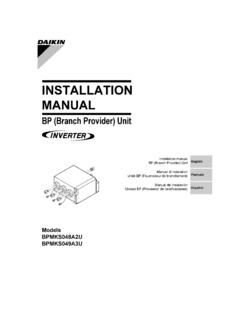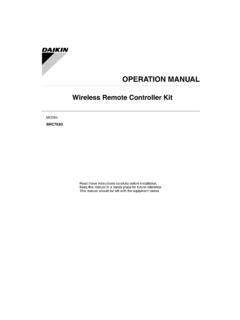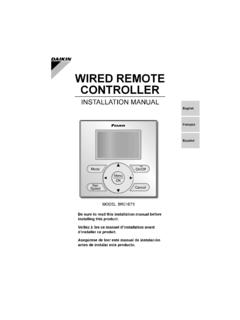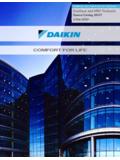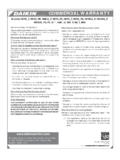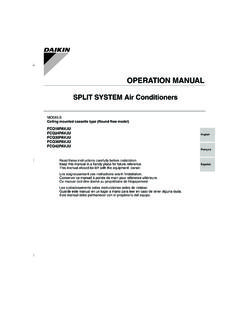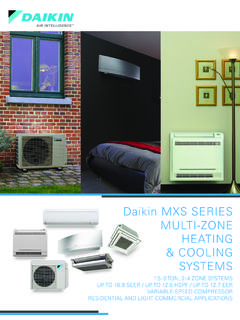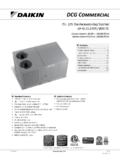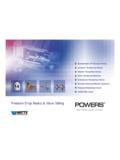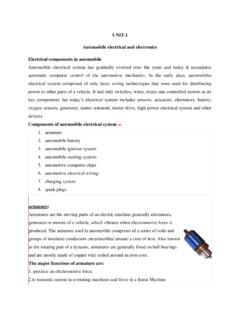Transcription of VRV Basic Operation Guide - Daikin AC
1 EGVUSE09-07C_a EDUS 39 - 600 - F3. Engineering Data Engineering Data VRV Systems Basic Operation Guide Engi- AMERICAS. 1645 Wallace Drive, Suite 110. Carrollton, TX75006. 2007. DACA EGVUSE09-07C Daikin AC (AMERICAS), AMERICAS INC. Printed in 09/2007 K AK FS. DACA EGVUSE09-07C_a VRV Systems Basic Operation Guide 1. Explanations of P-H Diagram (Refrigerant Characteristics Table) .. 2. 2. Concept of Basic Refrigeration Cycle .. 3. 3. Points of Refrigerant Control of VRV System .. 4. Cooling 4. Heating Operation .. 5. Compressor Capacity Control .. 6. Control of Electronic Expansion Valve .. 7. 4. Control of Indoor unit .. 8. Thermostat 8. Operation Range of Remote Controller Temperature Sensor.
2 8. Thermostat control in Normal Operation .. 10. Thermostat control in Dry Mode Operation .. 11. Drain (Condensate) Pump Control .. 12. Indoor Coil Freeze Prevention Control .. 13. Hot Start Control (In Heating Operation Only).. 14. Heater Control .. 15. Heater Control using Heat Pump Lockout Operation .. 15. Heat Pump Lockout 15. Types and Actions .. 15. Availability and Applicability .. 16. Heat Pump Lockout Functional Schematic .. 16. Example 1: AUX Duct Heater Integration* .. 17. Example 2: AUX Baseboard Heater Integration* .. 17. Example 3: Alternative Heat Source .. 18. Notes on Heat Pump Lockout Function .. 18. Fan Residual Operation .
3 18. Thermostat Control in Cooling / Heating Automatic 19. Louver Control for Preventing Ceiling Dirt .. 22. List of Louver Operations .. 23. 5. Other Functional Operations .. 24. Explanations on Main Functional Control .. 24. Cooling Operation .. 24. Heating Operation .. 24. Oil Return Operation .. 25. Cooling Mode (VRV Systems, RXYQ_M / REYQ_M) .. 25. Heating Mode (VRV Systems, RXYQ_M / REYQ_M) .. 26. Cooling Mode (VRV-WII Systems, RWEYQ_M) .. 27. Heating/Simultaneous Operation (VRV-WII Systems, RWEYQ_M) .. 28. Water Heat Exchanger (VRV-WII Systems, RWEYQ_M) .. 29. Cooling Mode (VRV-III Systems, RXYQ_P / REYQ-P) .. 30. Heating/Simultaneous Operation (VRV-III Systems, RXYQ_P / REYQ_P).
4 32. Defrost Control .. 34. Defrost Control (VRV Systems, RXYQ_M / REYQ_M) .. 34. Defrost Control (VRV-III Systems, RXYQ_P / REYQ_P) .. 35. Basic Information 1. Explanations of P-H Diagram (Refrigerant Characteristics Table) DACA EGVUSE09-07C_a of P-H Diagram (Refrigerant Characteristics Table). The following P-H (pressure, enthalpy) diagram shows characteristics of various refrigerants with pressure on the vertical axis and enthalpy on the horizontal axis. Isothermal line P(psi). Subcooled area PressureP(psi). (Subcooled liquid). Pressure Saturated area (Saturated vapor). Superheated area (Superheated vapor). Saturation curve Enthalpy h (btu/lb).
5 The change of state from gas to liquid is called condensing and that from liquid to gas is called evaporating. The boundary state of each change is called saturation, and the temperature generating saturation is called the saturation temperature. Saturation temperature depends on the kind of refrigerant and pressure. The characteristics of saturation temperature are shown on P-H diagrams of various refrigerants, and are called the saturation curve. The characteristics of temperature gradients for pressure and enthalpy are shown on P-H diagrams, called isothermal lines. By knowing the zone divided with saturation curve in which the intersection point of pressure and isothermal line is included, the information on the state of refrigerant can be provided.
6 The intersection above can be obtained by measuring pressure and temperature of refrigerant at a certain point. For single refrigerants such as R22 and R134A, the isothermal line has no gradient in the saturated area, that is, the saturation temperature under certain pressure is the same at both the liquid side and the gas side. For mixed or blended refrigerants such as R407C and R410A, in which multiple refrigerants with different boiling points are mixed, their isothermal lines have gradients in the saturated area, so the saturation temperatures under certain pressure are different at the liquid side and the gas side. They are called zeotropic refrigerants, with the exception that R410A is called an quasi azeotropic refrigerant.
7 States of refrigerants are classified in the following 3 categories: Superheated vapor: state that refrigerant is existing as gas Saturated vapor: state that is a mixture of liquid and gas (this is also called wet vapor). Subcooled liquid: state that refrigerant is existing as liquid. 2 VRV Systems Basic Operation Guide DACA EGVUSE09-07C_a Concept of Basic Refrigeration Cycle 2. Concept of Basic Refrigeration Cycle The following P-H diagram shows characteristics of various refrigerants with pressure on the vertical axis and enthalpy on the horizontal axis. Theoretical refrigeration cycle neglecting pressure loss is shown. The difference between temperature and pressure equivalent saturation temperature is called the Superheated Degree.
8 The difference between discharge pipe temperature and condensing temperature is called the Discharging Superheated Degree (DSH). The difference between return-air pipe temperature and evaporating temperature is called Return-air Superheated Degree (SH). Generally, superheated degree means return-air-superheated degree. The difference between temperature and pressure equivalent saturation temperature in subcooled liquid is called Subcooled Degree (SC). In order to prevent wet Operation (*), the superheated degree is calculated at the evaporator outlet, and the refrigerant flow rate into the evaporator is regulated with the expansion valve, so that the superheated vapor only is returned to the compressor.
9 * Wet Operation is a state of Operation where wet vapor not completely vaporized in the evaporator is sucked by the compressor, causing liquid return or liquid hammering. VRV Systems Basic Operation Guide 3. Points of Refrigerant Control of VRV System DACA EGVUSE09-07C_a 3. Points of Refrigerant Control of VRV System Cooling Operation Influenced by the number of operating (thermostat-on) units, capacity, airflow rate, return-air temperature, and humidity of indoor units: Load on total system changes. Loads on every indoor unit are different. When the thermostat is off, the motorized Outdoor electronic expansion valve is fully opened. valve is completely closed (0 pulse) to prevent refrigerant from entering the indoor heat Superheated degree control exchanger.
10 *1. Cooling Receiver Low pressure Operation Operation Stop Compressor Gas pipe thermistor Liquid pipe thermistor Compressor Capacity In order to maintain the cooling capacity corresponding to the capacity of evaporator and load Control fluctuation, based on the pressure detected by low pressure sensor of the outdoor unit (Pe), the compressor capacity is controlled so as to put the low pressure equivalent saturation temperatures (evaporation temperature = Te) close to target value. Superheated In order to maintain the superheated degree in the evaporator and to distribute proper refrig- Degree Control of erant flow rate regardless of different loads on every indoor unit , based on the temperature detected by thermistors on the liquid pipes and gas pipes, the indoor electronic expansion Indoor Electronic valve is regulated so as to put superheated degree at the evaporator outlet close to target Expansion Valve value.
